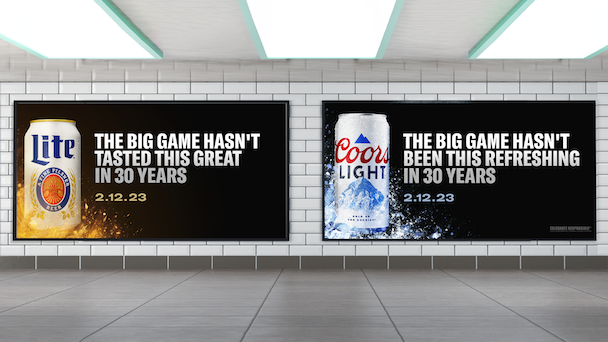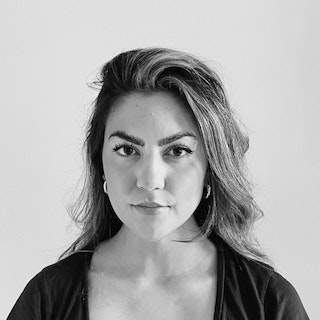As AB InBev’s exclusive Super Bowl reign comes to an end, the beer wars get fizzy
Will the Budweiser parent maintain its dominance in the Super Bowl? Beer market analysts and brand leaders weigh in.

Molson Coors – alongside a handful of other alcohol category players – will be back in full force at this year's Big Game / Molson Coors
Football fanatics and bandwagon buffs alike have long associated the Super Bowl with Budweiser’s clydesdales. That’s because beer behemoth Anheuser-Busch InBev (AB InBev) – which owns not only Budweiser but other top beer brands including Corona, Busch Light and Stella Artois – has owned exclusive advertising rights to the Big Game in the alcohol category since 1988.
This year, things are changing. The conglomerate, which is the largest beer company in the world, has relinquished its iron grip on the event. While it will still have a presence in the game on February 12, competitors will be welcomed back to one of the biggest stages in advertising. Confirmed players include Molson Coors, Heineken and Rémy Cointreau.
Advertisement
Is AB InBev huddling on a new strategy?
The decision to dial back its Super Bowl presence has been a long time coming for AB InBev, according to some.
“AB was already dispersing its ad time over several brands over the last few years,” says Mandy Naglich, a food writer, social media consultant and beer expert. “Instead of a constant focus on the Budweiser and Bud Light brands, AB gave significant ad time to Michelob Ultra, various Bud Light Seltzers and even threw in a corporate spot in 2021 focusing on the company behind the beer, rather than the beer itself.” Plus, she points out, most gameday viewers “don’t know or care that Michelob Ultra and Bud Light are brewed by the same company, and already see those ads as being for two different beers.”
Other industry analysts share Naglich’s hunch that the renunciation of its exclusive rights won’t hurt the beer titan much – especially considering the growing value that brands are finding in pre- and post-game marketing activations that come at lower price tags. “It’s not necessarily the smartest play these days to pile so much investment into a few in-game Super Bowl ads, or in the case of Anheuser-Busch, to pay up for exclusivity,” says Duane Stanford, editor and publisher of Beverage Digest, a US-based business newsletter covering the beverages industry. “Brands like Anheuser-Busch and PepsiCo in recent years have learned there is mileage to be gained by investing in smart marketing before and after the game. That also means shifting some Super Bowl spending to targeted ads in regional markets where your core beer drinkers sit, and to digital where the next generation of consumers live.”
David Steinman, vice-president and executive editor at Beer Marketer’s Insights, suspects AB InBev is recalibrating its strategy to squeeze greater returns out of its ad spend. He suggests the conglomerate is “looking to spend more efficiently on top of reallocating [spend] from Super Bowl exclusivity to spread out throughout other key parts of the year – like summer.” (He’s onto something: 40% of total annual beer sales happen from May to August, per data from the National Beer Wholesalers Association).
Still, AB InBev is hedging its bets by securing three minutes of in-game advertisements, which will include a Caddyshack-inspired Michelob Ultra spot starring Tony Romo, the debut of a new Bud Light campaign, a Busch Light spot and regional Budweiser buys fronted by actor Kevin Bacon.
But without its prior exclusivity, AB InBev is giving competitors the chance to swoop in and build brand consideration. At around $7m per 30-second spot, according to host network Fox Sports, it’s no small investment. But the price tag promises what so many consumer brands demand: reach. To offer a sense of scope, last year, the NFL estimated that more than 208m people tuned into Super Bowl LVI.
As Steinman puts it: “It’s definitely an opportune moment for companies like Molson Coors, Heineken, Diageo and Remy to showcase their brands – though an expensive one at that.”
Advertisement
Molson Coors doesn’t have to ‘sneak through the side door’ any more
This year, Molson Coors, the parent company of Miller and Coors, will return to the Big Game after a 33-year hiatus. In recent years, Molson Coors brands have piggybacked on the pre- and post-game hype with a range of clever activations, but the company is pleased to be back in the spotlight.
“The Super Bowl is the largest beer-selling moment outside of summer and that’s why we’ve spent so much energy inserting ourselves into the conversation over three decades, sneaking in through side doors or chimneys or any other way we could,” a Molson Coors spokesperson tells The Drum. “We couldn’t turn down the opportunity to get back into the game through the front door this year.”
But the spokesperson says its 30-second spot – which, created in collaboration with Droga5, was teased in a recent New York Times print ad that implied that Miller Lite and Coors Light will be battling it out for the spotlight – isn’t the sum total of the brand strategy. “Just because we now have a national commercial, that doesn't mean our guerilla mindset is going to change … We are not relying on a spot alone to entice fans.”
Elaborating, the spokesperson says that Molson Coors has “always treated the Super Bowl as a season, not a day,” and that it’s crucial “to keep fans on their toes throughout” the season. “We of course need to make sure that we capture attention and entertain for those 30 seconds on air, but ultimately, our focus is about engaging consumers early on and giving them reason to reach for our brands and our beer during the Super Bowl season and throughout the rest of the year.”
While the full details of Molson Coors’ marketing plans remain under wraps, the spokesperson offers a teaser, promising that the spot “will include several firsts, both for Molson Coors specifically and Super Bowl advertising generally.”
Molson Coors is straightforward about its objectives: “We want to build our brands, and we want to sell beer,” the spokesperson says.
Steinman, for his part, suggests that Molson Coors’ presence will “makes for a more competitive game day on the ad front.”
He points out that sales of both Miller Lite and Coors Lite have outpaced those of Bud Light in recent years. “The Super Bowl is certainly viewed by Molson Coors as an opportunity to gain more ground,” he says. “At the same time, Michelob Ultra sales have been outperforming all of the mega brand light lagers for many years running, surpassing Coors Light by volume in 2022 for the first time.”
Heineken bets on zero
Heineken will be another top contender at Super Bowl LVII. It’s showing up with a 30-second Marvel co-branded spot. Fronted by Paul Rudd, who plays Ant-Man in the forthcoming superhero flick “Ant-Man and The Wasp: Quantumania,” the ad will promote Heineken 0.0, the brand’s zero ABV offering.
The spot will expand on a campaign kicked off this month in recognition of Dry January – a campaign in which drinkers swear off alcohol for the first month of the new year. As the top-selling non-alcoholic beer brand in the US, according to recent data from IRI, Heineken 0.0 is looking to capitalize on consumers’ growing interest in more conscious consumption and the nascent ‘sober-curious’ movement.
“What we’re trying to do here … is share the way people can enjoy responsibly – and make moderation more meaningful for consumers. That has always been a top priority [for the brand],” says Borja Manso Salinas, vice-president of marketing at Heineken USA. “This more nuanced message [is something] that a platform as iconic as this – with a partner like Marvel – can deliver so much better than conventional communication.”
Salinas says that a key goal is helping to grow the non-alcoholic beer category in the United States market. Heineken played a major role in commercializing non-alcoholic beers beginning in 2017. At the time, the share of non-alcoholic beer sales in the US hovered around .4%, compared to nearly 10% in some parts of Europe. In the years since, the category has nearly doubled in size, but the US market still lags behind other developed countries.
To further its goal of growing the category more broadly, Salinas says there’s no forum more fitting than the Super Bowl. “Bringing something like non-alcoholic Heineken to such a big cultural moment like Super Bowl – with such iconic pop culture partner like Marvel – helps us to make moderation cool and normal [to consumers],” Salinas says. “The reason why [the category] is so small is because, conceptually, a beer without alcohol is not something that a lot of people actually consider. So we have to bridge a substantial gap in consideration.”
When asked about whether growth in the non-alcoholic beer category will raise the stakes on competition, Salinas expresses confidence that a rising tide will lift all boats. “Of course, success brings competition,” he says. “We want to be seen as leaders and we want to maintain our market share leadership in dollars and grow. But we believe that a bigger cake will be beneficial for everyone.”
Salinas goes on to say: “We are very conscious of how small this [category] is, relatively speaking, and how big it can be. More competitors bring attractive options to the table and … will bring more consumers into the category and will benefit all of us. So even if our comparative market share declines slightly, we are absolutely obsessed with growing the category and sharing and promoting this notion that moderation is cool – and is a fantastic option.”
Advertisement
AB InBev is still ready to score
As far as making a lasting impact at this year’s Big Game, industry experts maintain a healthy degree of skepticism. “If another brand can create a spot as memorable and viral as the 90s Budweiser campaign ‘Wassup’ or as iconic as the Budweiser Frogs, they have a chance to claim part of the national consciousness around beer,” says Naglich.
AB InBev is likely to maintain some of its stronghold if only for its commitment to connecting with consumers who have come to associate Budweiser and Bud Light as part and parcel of the Super Bowl. “While there is always risk in sharing the staging with competitors, that risk is only as high as a brand’s inability to execute their plan,” says Beverage Digest’s Stanford. “The most capable and confident marketers focus on their own strategy and their consumers, and that appears to be what Anheuser-Busch is doing this year with the Super Bowl. Market share will determine whether they pull it off.”
For more, sign up for The Drum’s daily US newsletter here.
